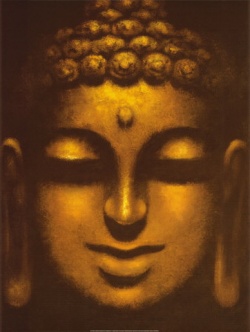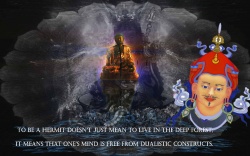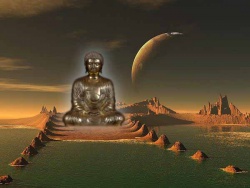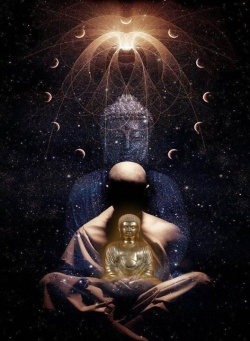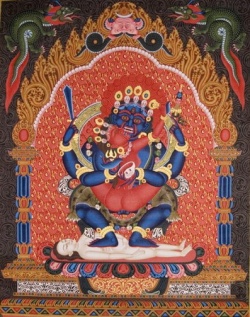Manual of Pramana - CLASS NOTES part 2
Class Six: Negative and Positive
GAK DRUP Negatives and positives. This topic, which focuses on negatives, is
negative positive very important for the study of emptiness. In America, many wrong ideas about emptiness and ineffective techniques for realizing emptiness have emerged. For example, emptiness is the luminous awareness of your mind, or you can see emptiness by totally clearing your mind of any and all content. A fundamental problem in these misunderstandings is the failure to realize that emptiness is a negative thing.
A Definition of Negative Things
GAKPA A negative thing. A negative thing is a chu, a thing which exists.
negative thing For example, emptiness is a negative thing which exists.
RANG NGU SU TOKPAY LU RANGGI GAKJA
it’s own directly perceives it state of mind its own thing we deny
NGU SU CHE NE TOK GUPAY CHU
directly eliminate perceive meaning existing thing
The definition of a negative thing is a thing which must be perceived by the state of mind which perceives it directly through a process of eliminating, directly, that which it denies.
In order for the mind to perceive a negative thing, such as emptiness, it first must exclude, or directly cut out, the existence of something – a self-existent thing in this case. Your mind can only perceive emptiness accurately by eliminating something; first you must focus on the absence of a self-existent thing. Emptiness is not a positive thing, such as the awareness of your mind. Emptiness is the absence of something. You perceive a negative thing by first excluding the thing which that negative thing denies. So to perceive emptiness directly or intellectually, you must first eliminate what emptiness denies: a self-existent object. This is why emptiness is a negative.
Three Examples of Negative things
1. CHU-NYI Thing-ness or selflessness. It means “the real nature of things.” This
thing-ness is the logic school’s term for emptiness. The real nature of things is a negative thing because if you want to perceive it you must first eliminate all things which are not it. (Note that this process of mental exclusion is different from the logic school’s description of the way you perceive something through a mental image or dun chi – by reversing everything which is not the thing; this was described in class three.)
2. NAM KA Empty space, or the absence of any physical obstruction. Namka
empty space literally means the sky; for example kam-dro is a sky-goer — a dakini or Buddhist angel, but in Buddhist philosophy namka means the space which an object occupies – empty space. When the object is occupying empty space, the space itself is still empty, which is why it is able to hold the object; and when the object is removed from the space, the space is obviously still empty. The place that the object occupies is always there, so empty space never changes. This is the deeper meaning of empty space. Empty space is defined as just the simple absence of any physical obstruction; it’s always there and it never changes and never functions. The point is that to be able to conceive of empty space, you have to mentally exclude the idea of an obstruction.
3. HLEJIN TSUNPO NYINWOR SE MI SA John Smith, the chubby guy, who
John Smith chubby daytime food never eats never eats during the day. This is a joke that refers to a chubby monk who never eats during the day; his not eating during the daytime is the negative – the absence of his eating. However, it implies that he must be sneaking some food at nighttime because something is making him chubby.
CHU SHEN PENPA It implies some other thing. By saying that chubby John
thing other it implies Smith never eats in the afternoon, you are implying that he must be binging at night.
Two Divisions of Negative Things
1. MEGAK A simple absence of something. Empty space and emptiness (or
simple absence selflessness) are examples. Emptiness is the simple absence of a self-existent thing, a thing that doesn’t depend on your karma. The test of whether you understand emptiness well is the extent to which other people can cause a mental affliction in you, and whether you would commit a bad karma when reacting to them. To be a negative thing, the term used to express it doesn’t have to contain any negative wording such as “not.” Two examples are empty space, and selflessness.
2. MAYIN GAK An absence where the words imply that it is not something
implies negative else. For example, the fact that sound is changing, which something implies that sound is not unchanging. Consider the statement, else “sounds are always changing things.” This is a negative concept because you can only conceive of it by eliminating something.
You must eliminate all cases where sounds would be unchanging things. Another example is “John Smith, the chubby guy, never eats during the day,” which implies that he must stuff himself at night. Another example is “what you cooked this time is really good.” This statement implies the exclusion of all the other bad dinners you cooked in the past. It seems that all general truths are mayin gak’s – negative things which imply something else; and all unchanging things are negative.
Common Ground
If you become a good Buddhist teacher, you will always be asked to prove things. You must remember that what you say is not a good reason for the person listening unless the three relationships required for a correct reason hold, and unless the listener accepts the three relationships as well as the language and concepts you use to express the three relationships. For example, you shouldn’t talk about hell realms until you have proven the likelihood that the mind continues on after the body stops moving. You must go back to common ground that you both accept. This is more important than the truth of your statement itself. In fact, according to Buddhist logic, your statement cannot be true unless the listener accepts your terms and the three relationships. Understanding this principle is critical because you can teach people to stop their death if you can catch them on common ground.
A Correct Reason that Involves a Nature
RANGSHIN GYI TAK YANGDAK A correct reason that involves a nature. This
its own nature of reason correct means that to be the thing given as the reason is to automatically be the quality you’re trying to prove. For example, to be a Chevy is to automatically be a car. Or, consider sounds; they are changing things, because they are made. To be a thing which is made is to automatically be a changing thing; and in this case, to be a thing which is made is to automatically be a changing thing. In this case the relationship between three (the reason) and two (the quality) goes both ways.
However, the reverse is not necessarily true: to be the quality you’re trying to prove is not necessarily to automatically be the thing given as the reason. For example, consider sound; it’s a changing thing, because you can hear it. All things that you can hear are automatically changing things, but not all changing things are automatically sounds. This relationship only goes one way.
Two Ways to Prove Something
1. LUNG Scriptural authority. You must use a scripture that is accepted by both
scriptural debating parties. For example, among educated Buddhists, the authority Abhidharma Kosha is accepted by virtually all Buddhist schools.
Class Seven: Contradiction and Relationship
The Importance of Studying Buddhist Logic
Without understanding Buddhist logic, you can’t really read madhyamika scriptures or serious scriptures about emptiness. These are very important subjects. Each short argument (kachikma) in the readings is an important separate lesson in itself. So try to slowly read a few of them, and then go to the middle section of the reading where we present our own position and be sure to get this part. Each kachikma has a very important point to make and clarifies our own correct position. None of them are silly or trivial. Each one will give you deep insight into an important point if you take the time to get into it. You should have a lifetime relationship with this material. Memorize parts of it and then debate it with other people. It’s like being married to the logic texts.
Contradiction and Relationship
GELN DREL Contradiction and relationship. These topics are very
contradiction relationship important for understanding emptiness and dependent origination.
GELWA Contradiction. The study of when two objects are contradictory to
contradiction each other.
DRELWA Relationship. The study of when two objects share a relationship with contradiction each other.
Two Features of a Contradiction
For two things to be in contradiction with each other, they must have these two conditions:
1. TADE Separate, distinct. The two things must be two separate things, and
separate both must exist. Neither thing can be non-existent, because you can’t discuss a contradiction between one thing that exists and another which doesn’t exist, because there’s only one thing there.
2. SHI – TUN MEPA No one thing can be both things at the
foundation harmony there is no same time. Shitunpa means one thing which is both A and B.
So the meaning of a contradiction between two objects is that both objects must be distinct from each other and there is no other thing which can be both objects at the same time.
Two Kinds of Contradictions
1. PENTSUN PANG – GEL A contradiction where two things are mutually
mutually eliminate contradiction exclusive. No one object can be entirely both things. This kind is a real contradiction. When you perceive one object, the other object is necessarily excluded. For example, a water pitcher, and everything which is not a water pitcher. This example of a mutually exclusive contradiction encompasses everything in the universe. Heat and coldness is another example. In this case, there are things which are neither heat nor coldness but no one thing can be both, so this is a mutual exclusion
Three examples of mutually exclusive contradictions:
TAKPA MITAKPA Unchanging thing and changing thing is an
unchanging changing thing example of a direct mutual exclusion, because one thing totally and directly excludes the other.
TAKPA NGUPO Unchanging thing and working thing is an
unchanging working thing example of an indirect mutual exclusion. thing “Coldness” and a “huge cloud of smoke” would be another indirect mutually exclusive contradiction.
NGUPO NGUME Working thing and a thing which does no
working thing non-working work is example of a direct mutually exclusive thing contradiction. Working thing, changing thing, and thing which is made all refer to the same material set of stuff, but the mental image that each term brings to mind is distinct for each.
2. HLENCHIK MINE GEL A contradiction where two things are
to stay together can’t contradiction diametrically opposed. They conflict with each other such that one works to eliminate the other. A scriptural example of a diametrically opposed contradiction:
NYENPO PANGJA A spiritual antidote and the negative personal
antidote, problem you quality which the antidote allows you to eliminate is counteragent want to eliminate an example. For example, death meditation will eventually eliminate laziness, and meditating on the rotting innards of your body will eliminate desire for sense objects. One thing acts against the continued existence of the other thing. This kind of contradiction describes a gradual process of one object encountering, working on and removing the other object. Emptiness and the ignorance that sees things as self-existent are mutually exclusive (pentsun panggel) because they can’t exist in one mind in the same instant, but they are diametrically opposed (hlenchik mine gel) in the sense that over time the developing understanding of emptiness will eventually remove the belief in self-existence.
Two Kinds of Relationships
DRELWA Relationships.
relationship
1. DAKCHIK GI DRELWA To be one thing is to automatically be the other
oneself of relationship thing. This is called a relationship of identity. For example, a changing thing and a thing which is made; this is a two-way relationship. A second example, car and Chevrolet, is only a one-way relationship because to be a Chevrolet is to automatically be a car but to be a car is not to automatically be a Chevrolet.
YUPA MITAKPA DANG GEL Being all existing things is contradictory
existing changing thing and contradiction to being a changing thing, but “being a thing changing thing” is not contradictory to “being all existing things.” So this is a oneway relationship. (This point relates to the previous section covering contradictions.)
BUMPA BUMPA DOKPA Water pitcher and the reverse of all that
water pitcher water pitcher reverse of is not a water pitcher is an example of one what it’s not thing automatically being the other thing.
Chevy and cars is another example.
According to the logic school, when you perceive the pen, you are perceiving the exclusion of all that the pen is not; but when you perceive the exclusion of all that the pen is not, you are perceiving the exclusion of all that is not the exclusion of all that the pen is not. The pen and the reverse of the pen’s opposite are nominally and conceptually distinct, but are the same ontologically – they are the same material stuff, but are conceived of through different processes.
2. DEJUNG GI DRELWAY The relationship of a thing and the thing which
came from it of relationship it came from. This is cause and effect, and it can only be a one-way relationship.
NGUPOY CHI – LOK SU JUNGWA NGUPO A working thing in the
working thing later flip working thing moment after it and the original working thing is an example. You can’t say that the original working thing shares a relationship with the working thing a moment after it, because at the time that the original working thing exists, the future working thing does not yet exist and has never existed.
Three Criteria for a Relationship of Identity
1. DAKNYI CHIKPA To be one thing is to automatically be the other thing. They
are the same thing materially or ontologically.
2. TADE The two must be separate things conceptually. separate
3. CHU DE ME NA KYU ME GU If one thing ceased to exist, the
thing that cease to exist this cease to exist other thing would have to cease to exist also. For example, if cars ceased to exist, then Chevies would have to cease to exist also.
A Correct Reason To Prove an Absence
MA MIKPAY TAK YANGDAK A correct reason to prove the absence of
not perceived reason correct something. This is extremely important. For example, consider this room full of educated Buddhists; it would be improper for anyone in this room to talk about hungry ghosts, if no one had had a valid perception of a hungry ghost. The thing that is absent in this proof is the propriety of anyone saying that hungry ghosts exist (if no one has seen one). The application is that you should not mention Buddhist ideas to others unless you have had a valid perception about the thing.
1. MINANGWA MA MIKPAY TAK YANGDAK A correct reason for proving
abstruse, hidden not perceived reason correct the absence of something which is difficult for the other person to perceive. The thing we’re denying involves something imperceptible to the opponent. Another example is: consider the guy standing in front of me; I can’t say that he’s not a Buddha, because I haven’t had a valid perception about it. The better you get at Buddhist logic, the more you realize how little you really know about others and how much you are assuming illogically about others; and then you collect bad karma by thinking about and treating them poorly based on your perceptions about them that are not valid.
2. NANGRUNG MA MIKPAY TAK YANGDAK A correct reason to prove the
apparent not perceived reason correct absence of something which the other person can perceive. The thing we’re denying can appear to a valid perception. For example, consider the top of this pen; there’s no car there because there’s no Chevy there.
Debating Tactics
Like Mohammad Ali, the great boxing champion, you should try to confuse and distract your debating opponent. The motivation is not to be competitive or to beat your opponent.
The point is to help your opponent to be able to focus his mind clearly in the middle of chaos so he can keep in mind his complicated responses. By practicing keeping your concentration, you will be able to focus clearly in future situations.
You can use the following format to review the class lessons. It will speed up your learning greatly.
Attacker: There are no different types of contradictions.
Defender: That’s not correct.
Attacker: Are you telling me there are divisions of contradictions?
Defender: Yes.
Attacker: Show me them.
Defender: Mutually exclusive contradictions and diametrically opposed contradictions.
Attacker: Are you telling me those are the two contradictions?
Defender: Yes, that’s right.
Some Other Responses In a Debate
UHN, or LAH What did you say? (this buys you time to think of a response)
SHOK Show me.
Dooooo CHIR Come on, show me something (give me an answer already!)
NGOoooooo TSA You should be ashamed (of that answer)!
KYEBA LUNG Give me the statement of necessity (the kyeba).
LEBTA Say something (quit stalling).
KORTEE KOR-SUM You just traveled in a big circular reason – for example, you
circle circle three accept that sounds are made and that anything that is made must be changing, but you refuse to accept that sound is a changing thing. You must be crazy!
Class Eight: Definitions and the Things They Define
Definitions and the Thing They Define
TSEN – TSUN Definition and the thing that is defined. This topic is critical. It definition thing defined established precisely the objects you’re debating. The rules of how a thing is to be defined must apply; they must be airtight.
TSEN-NYI The definition of a thing. For example, the definition of a
definition working thing is anything that performs a function.
TSUNJA That which you are defining. For example a working thing. thing defined
Material and Nominal Existence
DZE-YU Having material existence, made of stuff. This term is part of the name of
material three qualities that make a good definition (see next page). According to the logic school, things that have a material existence can be perceived without first constructing them from their various parts and then conceptualizing the whole. For example, objects of the five senses such as colors and shapes, or the mind itself. The logic school says that perceiving it doesn’t depend on perceiving its separate parts and then creating a conceptualization.
TAK-YU Having only nominal existence, made up by ideas; it exists only
Nominal conceptually. The logic school would say that to perceive things that have nominal existence you must first perceive the various parts and then put them together. An example from the lower madhyamika school would be your conception of a person, “John.” It means the idea of “John” which is neither his mind nor his body.
The concept of material existence (dzeyu) is applied on the following page when considering the three qualities of a good definition. The distinction between things that have a material existence versus those that have only a nominal existence is also extremely important in the mind-only school and in the madhyamika school.
Three Qualities of a Good Definition
DZEYU CHU – SUM TSANGWA Three qualities have to be complete for
material qualities three complete something to be a definition. Consider this definition of a working thing: it is a thing that performs a function.
1. CHIR TSENNYI YINPA Generally speaking, it is a definition. generally definition it is a It sounds like a definition. For example, “that thing that performs a function.”
2. RANGGI TSENSHIY TENDU DRUPPA It should apply perfectly to the
its own classic example on top of it exists classic example. For example, “a water pitcher.”
3. SHEN GYI TSENNYI MAYINPA It can’t be a definition for any other
other thing of definition it’s not thing. It must be precise or airtight, and apply only to the thing defined.
Three Conceptual Qualities of the Thing Defined
1. It can be defined appropriately. It sounds like a thing that is defined. Every existing thing can be defined.
2. It should apply to a typical function. The words “working thing” should apply to a water pitcher.
3. It shouldn’t be the thing defined by any other definition.
In the definition of a good definition (above), these three qualities are called the three material qualities. In the definition of something to be defined, they are called the three conceptual qualities.
The reason for this may be that the thing you are defining, for example, “fire,” is a conceptual thing, whereas the definition, for example “hot and burning” is more of a tangible material thing.
The thing that you choose as a classic example should combine the qualities of both the definition and the thing defined in one object. For example, a water pitcher should be both a working thing (the thing defined) and a thing that performs a function (the definition).
Direct Valid Perception as a Thing Defined
SARDU MILUWAY SHEPA GANG SHIK TOKDREL MATRULWAY SHEPA fresh unerring state of mind both A and B free of un-mistaken state of conceptualization mind
A fresh unerring state of mind that is non-conceptual and un-mistaken is the definition of a direct valid perception. Each word in this definition supports either one or both of the goals of a definition, described below.
Two Goals of a Good Definition
1. RIK MITUN SELWA Definitions which eliminate or disqualify things that
type dissimilar eliminates are dissimilar to the thing defined. These terms serve to disallow other dissimilar perceptions that might be mistaken for the thing defined.
For example, in the definition above of a “direct valid perception:”
–The term “fresh” eliminates or disallows the dissimilar types of “memory.”
–The term “unerring” eliminates the dissimilar type of “perceptions that are not valid.”
–The term “free of conceptualization” eliminates the dissimilar type of “deductive” perception.
2. LOK TOK SELWA Definitions which eliminate wrong ideas about the wrong idea eliminates thing defined. These terms address common misperceptions about the thing defined.
For example, in the definition above of a “direct valid perception:”
–The term “un-mistaken” eliminates the wrong idea “direct perceptions are always correct” (some people considered any direct perception to be correct even if it was distorted, as when you press your eye and see double vision).
–The term “free of conceptualization” also eliminates the wrong idea that “perceptions with conceptualization could be direct.”
A Correct Reason To Prove the Absence of Something Perceptible
One of the most important goals of Buddhist logic is to prove to yourself logically that much of the world is really unknown to you, and that you collect bad karma when you assume negative things about people which are really unknown to you and may be incorrect. This way of thinking disqualifies you from reaching a Buddha paradise. So logically speaking, you should be very skeptical about your perceptions about anyone’s apparent negative qualities.
NANG RUNG MAMIKPAY TAK YANGDAK A correct reason to prove the
appear possible not seen reason correct absence of something which is normally perceptible to the opponent.
Two examples:
Consider the surface of a dark, nighttime ocean;
There is no smoke out there,
Because there’s no fire out there.
Consider a bare rocky mountain crag;
There’s no juniper trees there,
Because there’s no vegetation there.
In these cases, the things used as the reason (fire, or vegetation), are normally the cause of the quality to prove (smoke, or juniper trees), so you’re proving the absence of the result by proving the absence of its cause. Without fire, there can’t be any smoke; and without any kind of vegetation, there can’t be any juniper trees. Smoke and juniper trees are easily perceptible to normal people.
The Format of a Debate
RIKPAY DROTANG The format of a debate; how it goes. This describes the pattern
debate the way it goes of statements made by the attacker and defender in a debate.
You should follow this structure, which begins by stating an incorrect reason, in order to get the debate going.
Attacker: Bumpa takpa yinpay chir. Because a water pitcher is an unchanging thing.
Defender: Tak madrup. Your reason is incorrect.
Attacker: Bumpa takpa mayinpa tel. Are you telling me water pitchers aren’t unchanging things?
Defender: Du. Yea, that’s right.
Attacker: Mayin te: Why not?
Defender: Bumpa mitakpa yinpay chir. Because water pitchers are changing things.
Attacker: Bumpa mitakpa yinpay tel. Are you telling water pitchers are changing things?
Defender: Du. That’ right!
Class Nine: Exclusion; Elements of a Logical Statement
SHEN-SEL Exclusion. The elimination of all which is not the thing. This topic is
other eliminate very important for the understanding of emptiness. Exclusions are not emptiness, but the topic addresses three common misperceptions about emptiness. For example, “all which is not sound.”
Three Kinds of Exclusion
1. DUN RAN GYI SHENSEL An exclusion which is the objectification of a
object- specific of exclusion specific instance of a thing. It means the act of ification instance creating a negative thing by considering the opposite of all which is not the thing. You establish what it is by mentally eliminating all that it is not. A pen, from the point of view of being the opposite of all that it is not, and a pen from the point of view of being a pen, are two separate ways of looking at a pen; and these are important for understanding emptiness. “Specific instance” here means one particular pen, as opposed to the generality of a pen. In the logic school, this kind of exclusion only applies to working things. It doesn’t apply to empty space. This is important because the lower schools believed that things exist because they function, and not because of your own karmic projections which is what madhyamika prasangika’s believe — even the rising of the sun is a projection of your mind. It is not an external independent event. Each working thing in the world has its own nature of being the opposite of all that it is not.
BUMPA MAYINPA LE LOKPA A water pitcher considered as the reverse
water pitcher it’s not than flopped over of all that it is not is an example.
2. LOY SHENSEL A mental exclusion. You create a mental image
mind exclusion of a negative thing by imagining all which is not the thing, and then you conceive of the opposite of that to arrive at the negative thing. This mental exclusion is very close to a dun-chi, or mental image (see class three), which is at the root of dependent origination because in the highest school you are mistaking a mental image for the actual object. It is defined as “the mental image that appears to conceptualization which is created by negating all that a thing is not.” The logic school says that anything that has no true nature of its own has an exclusion. A purple elephant in this classroom doesn’t exist, but it has it’s own emptiness – - so the quality of not being self-existent applies even to things that do not exist. So mental exclusions apply even to things that can only be imagined. You can picture the opposite of all that is not a purple elephant in this room (which doesn’t exist but can be imagined). An imaginary thing cannot function, but the image of a thing can function — to give you an ulcer, for example. In order to see emptiness directly you must be able to imagine what a self-existent thing would be like.
TOKPAY NANG YUL
conceptualizing appears object
An example is the conceptualization of the object that appears to you. It means the image that appears to conceptualization, e.g., the mental exclusion (loy shensel) of a rabbit’s horns.
3. ME GAK GYI SHENSEL An exclusion of a thing, which is a negative
not absence of exclusion thing involving the absence of the thing. It means that the object is not all that it is not. An exclusion and a negative are the same thing. This third kind of exclusion is a negative in the sense of being the simple absence of something (me gak). The first type of exclusion is a negative in the sense of not being something (that is, a mayin gak). For example, the pen is not all that is not – it is the opposite of all that it is not. The classic me gak is ultimate reality or emptiness. It is the simple absence of a self-existent thing. For example, a person or situation that could irritate you from its own side, independent of your karmic projections.
BUMPA MAYINPAY TONGWA An example is the condition of a water
water pitcher it’s not empty pitcher being devoid of anything that belongs to the group of things that it is not. When your mind thinks of this and draws a blank, you are thinking about emptiness.
The Elements of a Logical Statement
DRA CHU CHEN; MITAK TE; JEPAY CHIR; PERNA BUMPA SHIN
sound consider it’s changing it’s made because for example water pitcher it’s like
Consider sound; it is a changing thing, because it is a thing which is made.
It is, for example, like a water pitcher.
JORWA Putting it all together. This is the root word used for yoga or yolk.
put together Fourteen elements of a logical statement are outlined below.
The reason you give an example, like a water pitcher, is to put you and your opponent on common ground. The reasoning is obvious when you use a water pitcher, and then you can say that the same line of reasoning applies to sound as the subject.
1. DRA, CHUCHEN Sound is the subject.
2. DRA MITAKPA, DRUPJA Sound is a changing thing is the assertion.
3. MITAKPA, DRUBJAY CHU Being a changing thing is the quality to be proven.
being changing to prove thing
4. MITAKPA, NGU KYI DRUBJAY CHU Being a changing thing is the
being changing explicit of to prove thing explicit quality to be proven.
5. KECHIKMA, SHUK KYI DRUPJA CHU Being instantaneously changing instantaneously implicit of to prove thing is the implicit quality to be proven changing
6. DRA TAKPA, GAKJA Sound is an unchanging thing is the position we
sound unchanging what we deny deny.
7. TAKPA, GAKJAY CHU Being an unchanging thing is the quality denied.
unchanging we reject thing
8. MITAKPAY CHU, TUNCHOK All changing things is the group of similar cases.
changing thing group of similar things
9. TAKPAY CHU, MITUNCHOK All unchanging things is the group of dissimilar
unchanging thing group of cases.
dissimilar things
10. JEPA, TAK It’s a made thing is the reason.
it’s made reason
11. DRA JEPA, CHOKCHU Sound is a made thing is the relationship between
sound it’s made if 1 then 3 the subject and the reason.
12. JENA MITAKYE KYAB, JE-KYAB A made thing must be a changing thing
it’s made be changing it must if 3 then 2 is the positive necessity between the reason
and the quality to be proven.
13. TAKNA MAJEPE KYAB, DOK-KYAB A thing that isn’t changing can’t be
not made it must if not 2, not 3 a made thing is the negative necessity
between the quality and the reason.
14. BUMPA, TUNPE A water pitcher is the similar example.
water pitcher example
Two Kinds of Correct Reasons Relative to the Opponent
RANGDUN KAB KYI TAK YANGDAK A correct reason for your own sake, to
for your own sake of reason correct prove something to yourself. Buddhism really is a private thing. You need to use logic to prove emptiness to yourself, and to meditate on emptiness by yourself. Then you will know that you can’t judge anyone because you can’t read other people’s minds. You will realize that you can not prove that anyone around you is not a Buddha or tantric deity.
SHENDUN KAB KYI TAK YANGDAK A correct reason for others’ sake, to prove
for others’ sake of reason correct something to other people.
Class Ten: The Concept of Time
Presentation of the Three Times
DU SUM NAMSHAK Presentation of the three times: past, present and future.
time three presentation The different Indian schools, and especially madhyamika prasangika, have very different views on the nature of time.
DO DEPA The Sutrist or Logic School, which uses the sutras to prove things.
sutra These are the higher of the two hinayana schools.
RIKPAY JEDRANG Logic followers. This is a subset of the sutrist or logic
logic followers school. The following presentation on time is from their point of view.
1. DEPA Past time.
2. DATAWA Present time.
3. MA-ONGPA Future time, not yet come.
not come
MEPE NA TSENNYI ME [Past and future] don’t exist so there is no definition for
don’t exist definition none them. In an absolute sense, the past is gone, and the future has not yet come, so in general terms they don’t exist and can’t be defined. However, relative to a specific object that exists now, the past and future can be defined.
The Definition of the Past, Relative to a Water Pitcher
Two requirements are necessary in order to define the past. The past can only be defined relative to a specific object that exists in the present moment, such as a current water pitcher:
1. BUMPAY DUSU KYE SINPA By the time of the [current] water
water pitcher in the time began already pitcher, it [the past] must have already begun.
2. BUMPAY DUSU GAK SINPA By the time of the water pitcher, it
water pitcher in the time cease already must have already stopped.
The definition of the past, relative to the time of a water pitcher, is that time which has already begun by the time the current water pitcher exists, and which has already stopped by the time of the present water pitcher.
The Definition of the Present, Relative to a Water Pitcher
1. BUMPAY DUSU DRUP SINPA By the time of the [current] water
water pitcher at time of happened already pitcher it [the present] should have already happened.
2. BUMPA DANG DU NYAMPA By the time of the water pitcher, it
water pitcher with time equal should happen simultaneous to the water pitcher.
The definition of the present, relative to the time of a water pitcher, is that time which has occurred by the time the current water pitcher exists, and which is simultaneous to the present water pitcher.
The Definition of the Future, Relative to a Water Pitcher
1. BUMPA DUSU KYE SHINPA By the time of the [current] water
water pitcher at time of beginning in the act of pitcher, it [the future] is in the process of beginning.
2. BUMPA DUSU MA KYEPA By the time of the water pitcher, it
water pitcher at time of not beginning hasn’t happened yet.
The definition of the future, relative to the time of a water pitcher, is that time which is in the process of beginning, but hasn’t happened yet relative to the present water pitcher.
The Cause and Result of a Water Pitcher, and a Working Thing
1. BUMPAY GYU The cause of the water pitcher. This is a present object. You
water pitcher cause can say the cause of the current water pitcher exists in the present as a thing which is past.
2. BUMPAY DREBU The result of the water pitcher. This is also a present object.
water pitcher result
3. NGUPO A working thing. It exists in the present; it is functioning now.
working thing
The following terms describe something which is either 1) the cause of a water pitcher, 2) the result of a water pitcher, 3) a working thing, or 4) non-existent:
1. KECHIKMA That which only lasts for an instant: this is a working thing.
instantaneously changing By definition, a working thing only lasts for a moment.
2. KYE SHINPA That which is in the act of beginning: this doesn’t exist. It
beginning in act of hasn’t happened yet, so it can’t exist. It is not a future thing, because the future only exists relative to a specific object.
3. BUMPA LA TU TE MA-ONGPA That which is future relative to a water
water pitcher relative to didn’t come yet pitcher: this is the result of a water pitcher.
4. BUMPA DUSU DEPA That which is past by the time of a water
water pitcher at time of already pitcher: this is the cause of a water pitcher.
5. BUMPAY MA-ONGPA That which is future for a water pitcher: this is
water pitcher didn’t come yet the cause of a water pitcher. Is the future something which hasn’t come yet that you are moving toward, or is the future something you are moving through which then becomes the past? For whom is the pitcher a future thing? For the cause of a water pitcher.
In madhyamika, they say the current pitcher is the cause for the cause of the pitcher, because you couldn’t call it a water pitcher until the water pitcher has occurred. In this sense, there isn’t any cause for a water pitcher until the water pitcher has already occurred.
6. BUMPA DEPA That which is past for a water pitcher: this is the result
water pitcher past of a pitcher. The pitcher is past for the result of the pitcher.
7. JIK SHINPA That which is in the process of being destroyed: this is
destruction in the process of a working thing.
Four Schools’ View of Time
The highest school of Buddhism says that all three times – past, present, and future – do exists and are working things. They say that a past pen, for example, does exist.
The topic of karma provides the basis for debating whether or not the past and the future do exist. If I do a negative deed today, will it affect me in the future?
–Some logic school proponents would say that although the absolute future does not exist, your future karma does exist.
–The mind-only school says that the karma is stored and carried in a separate mental consciousness called the kunshi, or storehouse consciousness, until it meets the conditions that make it ripen.
–The Abhidharmist school says the karma stays in your five heaps as they travel forward into the future.
–The lower madhyamika would say that the seed created by your bad deeds stays in your mental consciousness and floats on from year to year in your mental consciousness.
Madhyamika Prasangika’s View of Time
The madhyamika prasangika school says that karmic seeds do not stay in your mind stream. Rather, the karmic streams are carried in “you.” They are carried in person as a projection, in the projected person. The reason a million years can go by between hitting someone on the head and being hit ten thousand times on the head is not that the karma sits around for a million years. It’s that a mental seed is created which is carried on by the person that you think you see, because you’re forced to see that. This gets very subtle. The karma stays with you as you are projected by your mind, forced to do so by your past karma. This is where karma really stays. A karma of the past can still affect you because a mental seed is planted in “you” as a projection of your own mind. It is carried in your projection of yourself as you move through time, as you continue to project yourself and those karmic seeds. Madhyamika prasangika accepts the mind-only school’s description of how karmic seeds are planted, are carried through replication, and then ripen by meeting the appropriate conditions. However, prasangika doesn’t accept that a separate consciousness has to be posited for storing the karmic seeds; the seeds simply stay in “you” as projected by your karma.
The madhyamika prasangika’s second answer to the logic school’s assertion that the past and future do not exist is called “parallel reasoning.” So how could the past and the future be working things? Consider a pen at the moment of its destruction. Does the destruction of the pen have a cause? Yes. And does the past pen which is destroyed have a cause? Yes. It’s destruction is the cause. So if it has a cause it must be a working thing. Therefore, anything that is destroyed must be a working thing and therefore must have had a cause. You can’t say there are causes for the birth of a thing, but that there are no causes for the thing itself.
Three Types of Incorrect Reasons for Particular Proofs
TAK TARNANG DE DRUP KYI An incorrect reason for a particular proof.
reason incorrect in a particular proof
1. DE DRUP KYI GELWAY TEN-TSIK The quality you’re trying to prove
in a particular proof contradiction reason totally contradicts the reason. For example, sound is not a changing thing because it is made.
2. DE DRUP KYI MA NGEPA TEN-TSIK The quality you’re trying to prove
in a particular proof not definitive reason is not definitely proven by the reason. For example, sound is something you can hear because it is a changing thing.
3. DE DRUP KYI MA DRUPPAY TEN-TSIK The reason given is inaccurate.
in a particular proof not to prove reason Something is wrong with the reason.
Seven types of inaccurate reasons:
1. The reason is non-existent: He is suffering because he’s been stabbed by rabbit’s horns.
2. The subject is non-existent: Consider the horns of a rabbit…
3. The quality is also the reason: Sound is a changing thing because it’s a changing thing.
4. The subject is the reason: Sound is a changing thing because it is sound.
5. The subject is the quality to prove: Consider sound; it’s sound because it’s changing.
6. The reason does not apply to the subject: Sound is a changing thing because you can see it with your eyes.
7. Part of the reason is incorrect: Trees have minds because at night their leaves curl up and go to sleep.
If the opponent doubts one of the elements to your argument, your reason is incorrect. So the final type of bad reason is called “bad for the particular school you are debating with.” The Jains, for example, should not say to Buddhists, “consider a tree; it has a mind, because it dies when you peel the bark off of it,” because Buddhists don’t believe that a tree “dies” – they believe it just dries up. The point is that we must be logical when defending Buddhism to other Americans. Buddhism says that you can avoid death and reach a tantric paradise in this life if you do your practices well and track your vows regularly. If you don’t present Buddhist ideas in a logical and compelling way that others can accept, you have destroyed their chances to avoid death. You must find common ground that they can accept logically. The world-view of western civilization is wrong, and you can save people’s lives if you present Buddhism to them logically.
Class Eleven: Course Review
Physical Matter and the Dharmadhatu
The real meaning of the term Dharmadhatu is the subject of the consciousness of the mind. It’s what your mental sense looks at. It’s the bunch of stuff that your mind perceives; for example, the thoughts that you hear, or the pictures you make in your mind. Physical form includes the purple that you see in your mind when you hear “purple elephants;” it is a color and is physical form, but you can’t perceive it with your five senses. So the definition of physical matter is anything that you can show as physical matter.
Also, there is a distinction between particulate matter, which is made up of tiny atoms of stuff, and matter in general. The Buddha’s sambhogakaya, which he has in his heaven, is not made up of atoms but it has colors and shapes. You can see it and it’s physical matter, but it’s not like particulate matter.
Meditation on Subtle Impermanence and on Quality and Characteristic
A good meditation to do following the completion of this course is to meditate on subtle impermanence and on quality and characteristic, which were described in classes two and three. It takes a lot of virtue and careful thought to get these topics. You can alternate in meditation on these two topics.
To meditate on quality and characteristic, try to see the difference between car and “car.” In English, we can distinguish between car, “car,” a car, and the car. If you meditate on these distinctions for a month, you might get very close to seeing dependent origination which is very difficult. We are all using ideation or conceptualization to get to things. Why do you use archetypes or mental images (dun-chi’s) to perceive things?
To meditate on subtle impermanence, focus on the reason that it’s true that the beginning of a thing destroys that thing. Why does the birth of a child kill that child, without any other external forces needed? The creation of a thing destroys that thing without any other intervening factors needed. Also, consider why we say that an object, for example a rosary, has a beginning, a staying, and an ending, but the emptiness of the rosary (the fact that it’s not anything other than a projection forced on you by your past karma) is unchanging and it does not begin or end. The rosary is a changing thing (mitakpa) but the emptiness of the rosary is an unchanging thing (takpa) and you can only say that it comes into being and goes out of being, but doesn’t begin nor end. When you destroy the rosary, it’s emptiness goes out of existence but it doesn’t end. You must meditate on this.
The Validity of Logical Perceptions
The logic school defines valid perception as a fresh unerring perception. Valid perceptions are divided into direct perceptions and conceptual perceptions. It is important to realize that conceptual perceptions are just as valid as direct perceptions. We in America tend to focus only on what can be seen, touched and bought. But at this point in our study, we can only perceive the goals and concepts in Buddhism — such as future lives and different realms – through logical perception. The initial perceptions of emptiness and future lives can only be believed through logic; then later we will be able to see emptiness and our future lives directly. This is especially true of the secret teachings, which totally operate off of logic. If you trust your emotions or your culture you won’t be able to practice them.
Your natural instincts and culture reject these things and so much of it is invisible and can’t be confirmed with your senses. You must function through your spiritual sense based on logic.
You have to establish truth by thinking carefully, and not ignore things just because you can’t see them directly with your senses. Death is real and what happens to you after death is real whether or not you can see it right now. The forces that created this world and are creating your death are invisible but you better figure them out, and you don’t have much time.
Does Samsara Have an End?
A brief debate:
Because the cycle of pain does have an end.
Wrong.
Are you telling me the cycle of pain doesn’t have an end?
Right.
Why not?
Because the cycle of pain has no front end.
That doesn’t mean it can’t have an end!
Are you telling me the cycle of pain does have an end?
Right.
Why so?
Because the cycle of pain has a back end.
Why so?
Because there is a powerful antidote that will smash our habit of seeing things as self-existent!!! The tendency to hold things as self-existent has a powerful antidote, which is called the direct perception of emptiness. This proves that you don’t have to suffer anymore.
See also
- Manual of Pramana - Reading One: Why Study the Art of Reasoning?
- Manual of Pramana - Reading Two: An Outline of All Existing Things
- Manual of Pramana - Reading Three: Quality and Characteristic
- Manual of Pramana - Reading Four: Causes and Results
- Manual of Pramana - Reading Six: Negative and Positive
- Manual of Pramana - Reading Seven: Contradiction and Relationship
- Manual of Pramana - Reading Eight: Definitions and the Things They Define
- Manual of Pramana - Reading Nine: The Concept of Exclusion in Perception
- Manual of Pramana - Reading Ten: The Concept of Time
- Manual of Pramana - CLASS NOTES part 1
- Manual of Pramana - CLASS NOTES part 2




